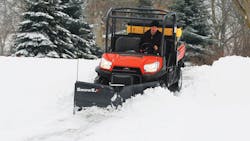What Snow Tools Work Best on UTVs?
Historically, being on a crew responsible for removing snow and ice from sidewalks has been cold, manual labor. Although parking lots and roadways can be salted or plowed from the comfort of a warm truck, sidewalks required hands-on labor and more direct exposure to the elements.
A growing solution is the use of compact utility vehicles (UTVs) for this job. It eases both the physical toll on personnel and improves the efficiency of clearing sidewalks in the winter. Equipment manufacturers have responded by developing professional-duty winter tools specifically designed for use on UTVs. These products include snow plows, spreaders, and sprayers.
Iverson is product manager for SnowEx.
Obviously, there’s no comparison between performing winter maintenance with a vehicle versus doing it by hand. A well-equipped compact utility vehicle is simply more productive. This increased productivity allows contractors to formulate a more predictable plan for handling a snow event.
With manual crews, more snowfall naturally equates to more labor. This increases cost and slows response time when trying to attend to multiple jobs. When using a UTV, operating costs are more standardized, as many sidewalk jobs require the same amount of effort, regardless of how much snow actually falls.
Using a UTV instead of hand labor reduces worker fatigue and lowers the risk of injury. If the UTV has an enclosed cab, operators are less exposed to the cold and snow, which further contributes to enhanced safety and productivity.
All things considered, it’s easy to see how operators can address an existing portfolio of contracts more quickly. This improved efficiency allows contractors to expand their operations by adding more jobs, or larger jobs, than would have been previously possible.
UTV plows
Plows built for UTVs are obviously more compact than snow plows made for trucks, but leading manufacturers are actually using the same high-strength, low-alloy steel when designing their professional-duty UTV products. Not only does this add durability to the plow, but it also helps protect the UTV from suffering unnecessary stress.
Both straight blade and V-plows are available to account for differing sidewalk widths and other factors. Contractors can take advantage of the versatility of a V-plow by making a first pass with the unit in the V position to push through the snow pile, throwing snow to either side of the sidewalk. Then the plow can be moved to the straight position and angled to either side. This allows the UTV and plow to remove the remaining snow and clean the sidewalk down to the pavement.
A V-plow in scoop mode can also be utilized to carry and transport snow to specific spots along the path. Switching this single piece of equipment from mode to mode as needed can be done easily with hydraulic controls. This allows operators to remain seated and safe in the UTV throughout the whole process.
Drop spreaders
A UTV can become a full-fledged sidewalk solution for winter maintenance when outfitted with a plow on the front and a spreader on the back. The drop spreader, in particular, has become the preferred choice for applying bagged ice melters or bulk rock salt to icy sidewalks.
The key advantage of using a drop spreader is its ideal spreading width of 3 to 4 feet and precise control of material flow. The unique drop design allows material to be placed exactly where it is needed—on the sidewalk—preventing bounce and scatter into landscaping and turf. This both reduces material waste and helps protect lawns and other green spaces from harmful chlorides.
The drop spreader is not a new concept and may not look that sophisticated, but many improvements have been made to make these products perfect for sidewalk maintenance. With UTV spreaders being sized specifically for sidewalks, it’s possible to treat the pavement in one pass without wasting material.
The best drop spreaders on the market offer a highly precise material feed system that lets the operator apply the correct amount of deicer necessary for the job while maintaining consistent coverage. This functionality is controlled with a user-friendly control dial mounted inside the cab. Another advancement in these leading systems is a gateless design that won’t leak material between applications.
Brine sprayers
Yet another equipment option is a UTV sprayer, which can be used to apply brine to bare pavement before a winter event begins. As the liquid evaporates, it creates a fine layer of salt on the sidewalk that will remain for several days. The salt layer prevents new snowfall from ice bonding with the pavement. This preemptive treatment makes it easier to plow snow after the event, and it typically leaves no residual ice. On average, anti-icing in this fashion requires 75 percent less salt than spreading to achieve the same result after an event.
Today’s sprayers provide optimal control over the amount of liquid solution being applied. The manner in which the brine can be applied is also a key consideration. Spray booms are now offered with 3-position spray nozzles that allow the operator to adjust how material is sprayed, shifting between triple stream, single stream or fan spray to best address the task at hand.
Some sprayers also include a hose reel with a peripheral spray wand to address areas off the sidewalk where the UTV can’t easily reach. Brine adheres well to vertical surfaces such as curbs and steps, making a spray wand a handy tool to treat these locations.
Source: SnowEx





